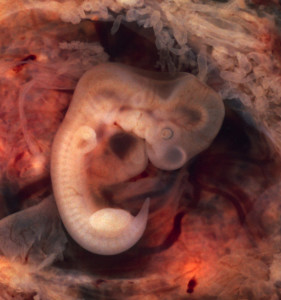You may have wondered if there are any real cases of people with tails. In this article, we are going to learn about human tails from an evolutionary perspective. We will also attempt to answer some of the most interesting and common questions people have on this particular topic. All of our information is based on thorough research using various reputable sources. If you need additional information on this topic, we will also provide some links that will take you directly to the source.
The Evolutionary View Of Human Tails
Interestingly, although most invertebrates do not have tails (such as crabs and the majority of insects), every species of mammal has a tail at some point in its development. Even human embryos will have a tail-like structure during their fifth to eighth week of development. The tail is only present for a period of 4 weeks, with it being most prominent in embryos 31-35 days old.
Does The Coccyx Serve A Purpose For Humans?
Humans have a coccyx (also referred to as the tailbone) that is located below the sacrum (the triangular bone located at the base of the spine). It is made up of 3-5 (usually 4) rudimentary vertebrae. Although the tailbone no longer assists in balance and mobility like it once did for our distant ancestors, it does serve a few secondary functions. Below are three functions of the coccyx. These secondary functions may be the reason why the coccyx hasn’t disappeared completely.
#1 Serves as an attachment site for tendons.
#2 Functions as an insertion point for some of the muscles of the pelvic floor.
#3 Supports and stabilizes a person while they are in a sitting position.
Why Did The Ancestor Of Apes And Humans Lose Their Tails?
Scientists say humans have a vestigial tail (a structure that has lost all or most of its original function) that at one time was long and useful for our early ancestors. However, in the course of evolution, it became less useful, which could explain exactly why humans no longer possess a tail.
Take a look at certain animals with tails (such as cats and dogs). They obviously move on four legs. For them, it makes perfect sense to possess a tail because it is necessary in assisting in balance. However, humans became bipedal (use only two legs for walking), which means our center of gravity passes vertically down our spine. Therefore, it was no longer necessary to have a tail to help counterbalance the weight of our heads. Plus, modern humans no longer need a tail to help them hold onto things while they swing through the trees of the forest (like our ancestors did).
These are just a couple of theories to why humans lost their tails. No one really knows for sure.
Modern Humans With Tails
Cases of human tails are very rare. Over the past fifty years, there have only been a few hundred documented worldwide. Luckily, researchers were able to actually study some of these rare cases. Medical researchers have divided the human tail into the two general categories listed below.
#1 True Tails
As the human embryo develops into a fetus, the white blood cells will eventually dissolve the tail. Although it is extremely rare, there have been some cases of modern humans born with a tail. This is an example of atavism. The term “atavism” is defined as a trait of distant ancestors that actually reappears in modern day. The size of human tails vary from just a couple of centimeters long, to over 5 inches long on a newborn baby. They are usually surgically removed shortly after birth.
The true tail extends from the tailbone. According to Wikipedia’s article on human vestigiality, since 1884, there have only been twenty-three cases of human babies born with “true” vestigial tails.
What Causes A True Tail?
A true tail results from incomplete regression of the most distal end of the normal embryonic tail found in the developing human fetus. Although some researchers believe it is an evolutionary regression, others think it is only a disturbance in the development of the embryo. Interestingly, there has been a case where the tail was inherited though at least three generations of females.
A true atavistic tail contains adipose and connective tissue, blood vessels, nerve fibers, sweat glands, sebaceous glands. They are covered by normal skin and even contain hair follicles.
Why Some Researchers Do Not Like The Term “True Tails”
Some researchers say that even “true tails” in humans do not deserve the name. Yes. They clearly resemble a tail, and are in the location where one would expect to see a “vestigial tail.” However, unlike tailed animals, it always lacks bone tissue (also lacks cartilage, notochord, and spinal cord).
There has never been a documented case of human tails containing bone. After you learn about what these tails lack, you can certainly see why some researchers say the name “true tails” is a bit of stretch.
#2 Pseudo-tails
Unlike true tails, pseudo-tails (or false tails) are not located at the base of the tailbone. They are often found in other areas along the lower back (occasionally off to the side from the backbone). Pseudo-tails are just lesions (of various types) that have a superficial resemblance to true tails. They can be associated with the condition known as spina bifida. Pseudo-tails may also be complications of various tumors, various malformations, or even the remnants of a parasitic twin.
Pseudo-tails Can Contain Bone
Sometimes, pseudo-tails will contain bone. However, they do not contain vertebrae.
Chandre Oram: The Man With A 13-Inch Tail
Above is a short YouTube video on Indian tea estate worker Chandre Oram. Due to his 13-inch long monkey-like tail with lots of hair, many travel hundreds of miles to see him for the purpose of receiving his blessings. Many of Oram’s followers believe that he is an incarnation of the Hindu monkey god Hanuman (shown in the portrait below). Some have even reported that after simply touching Oram’s tail, they were healed from their illness. Besides having a tail similar to a monkey, Oram claims to also enjoy acting like a monkey by climbing, jumping, and even eating bananas.
Despite claims by Oram and his followers, scientists say he doesn’t possess a real tail. It is nothing more than a birth defect, which is a form of spina bifida. Oram married in 2007 and currently has one child. He refuses the surgical removal of his tail and has big plans for the future. Oram hopes that one day, he will have enough money to build a temple to accommodate his many followers.
Hanuman The Hindu Monkey God
Conclusion
Being such an extremely rare abnormality, the human tail is a curiosity that many would travel hundreds of miles to see. Since the late 1800s, there were not many documented cases of people with “true” tails. Will there be a lot more in the next 100 years or so? Of course, only time will tell.




